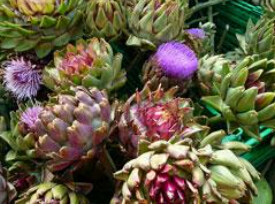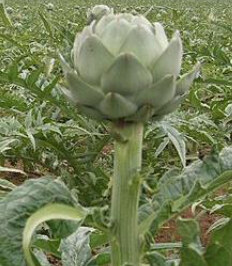Cynara scolymus
Download info sheetCynara scolymus, Globe Artichoke, is a well known vegetable, and an effective landscape design plant—it is so much more.
Identification: Globe Artichoke is an herbaceous perennial, which belongs to the Asteraceae family. They are related to thistles, as you can see from the flowers, sometimes called the ‘French Artichoke’. Although in the same family, it is a different plant to Jerusalem Artichoke (Helianthus tuberosus), from which you harvest the roots. Cardoon, Cynara cardunculus, is though, a close relative.
Cultivation: Artichokes originate from around the Mediterranean region, and have spread to most countries as some Europeans colonised the world, particularly the Italian and French. The English were a bit slow to adopt it as a food and medicine. The first English writings are from 15th Century.Along the central coast of California, Castroville, has made this a major crop and calls itself the ‘Artichoke Capital of the World’. They have an Artichoke Festival each May to celebrate their famous crop. The first ‘Californian Artichoke Queen’ was crowned on 1949, her name was Marilyn Munroe! It grows between 1-2 metres high. They thrive best in full sun and fertile soil, they des (Image: Christchurch Heritage Garden; Karina Hilterman)cribe it as frost hardy but drought sensitive, so to ensure a healthy plant water during summer and mulch well. It is a stunning plant to grow with its arching deeply serrated leave and wonderful big fat flower buds that open to a vibrant purple thistle (if the budsaren’t all eaten as ‘chokes’). Cut back the plant to ground level at the end of the growing season to stimulate new growth. They usually regrow for a few years, new plants can easily be grown from seed, so make sure you leave some flowers to mature of this purpose.
(Image: Christchurch Heritage Garden; Karina Hilterman)cribe it as frost hardy but drought sensitive, so to ensure a healthy plant water during summer and mulch well. It is a stunning plant to grow with its arching deeply serrated leave and wonderful big fat flower buds that open to a vibrant purple thistle (if the budsaren’t all eaten as ‘chokes’). Cut back the plant to ground level at the end of the growing season to stimulate new growth. They usually regrow for a few years, new plants can easily be grown from seed, so make sure you leave some flowers to mature of this purpose.
Companion Planting: They like to grown near; Tagetes marigolds, basil, lavender, asparagus, alliums, mint, squash, spinach, lettuce, and tomatoes. They dislike growing near; walnuts, cornflowers, sunflowers, carrots, potatoes, brassicas.
Energetic Character: Bitter, salty, astringent.
Constituents: The whole plant is nutrient rich, including; volatile oils, bitters (including cynarin and sesquiterpene lactones), amino acids and tannins. Vitamins; provitamin A, B1, B2 and C, folic acid, Minerals, calcium, iodine, iron, magnesium, potassium, zinc, plus flavonoids, (including scolymoside, inulin, cynaropictin), phenolic acids, enzymes, taraxasterol, and sugars.
Therapeutic actions: This herb is a wonderful liver and gall bladder tonic! Hepatoprotective, cholagogue, diuretic, choloretic, and liver restorative, bitter tonic. Diuretic, anti-nausea, carminative.
Part/s Used: Leaves, stems and root medicinally. The immature flowers (chokes) are delicious and nutritious.
Harvesting: The leaves are optimally harvested just before the plant flowers through to when the chokes are harvested, though they can be picked and used through summer.
Medicinal uses: Historically, Globe Artichoke was consumed to assist with purifying the body, reducing body odour. Research has shown that regular use of Globe Artichoke leaf lowers elevated cholesterol levels. This will reduce the risk of development of gallstones and ‘clogged arteries’, which are caused by high lipid levels in the blood. By improving liver function, Artichoke has a purifying effect on the body, this assist to relieve ‘arthritic type’ symptoms and gout. It is also good to take regularly if you have diabetes or high blood sugar levels; particularly if you ‘are carrying more weight that is good for you!’ It will assist you to lose weight by stimulating your body. It could be would suggested to take it easy on the chokes with buttery accompaniments and stick to infusions of
the leaves. The chokes without the rich dips are good for you though.
“Give is herbalists the artichoke leaves and we will take care of all those tired livers” - Christophe Bernard, Herbalist
Dosage: Infusion: (dry herb or fresh plant equivalent), is 6 grams/1-3 cups daily. Tincture: 4–10 mls daily.
Cautions & Contraindications: Take care with using Globe Artichoke when also taking diuretic or anti-diabetes medications. The tannins may inhibit the adsorption of calcium; take at least 2 hours apart. “Artichokes suit elderly people at all times, and those of a phlegmatic and melancholy disposition.” From ‘Treatise on Food’ 1702 - Louis Lemery (1677-1743), French Doctor, Chemist and Botanist.
Other Uses: The flowers are wonderful to use in floral designs, and are easily dried for display through winter. Artichokes can be used as dye plant, creating a yellow coloured dye. It can also coagulate milk, in some parts of Spain; a strong infusion of Cardoon (a very close relative) is used in cheese making, as a substitute for rennet - this would suit vegetarians who love cheese.
 (Image from: http://www.pfaf.org/user/Plant.aspx?LatinName=Cynara+scolymus)
(Image from: http://www.pfaf.org/user/Plant.aspx?LatinName=Cynara+scolymus)
Culinary Uses: There are many ways to eat the flower heads, from simply boiling them and them enjoying them with a vinaigrette, melted butter or even better mayonnaise or aioli, to stuffing them with a variety of ingredients and either fry or bake. Some fry the sliced young heads in olive oil. The young stems can be cooked and prepared as a vegetable in a similar way to the buds.
Traditionally the French and Italians drank the water that the chokes were cooked in, as it is a liver stimulant and prepares the body better for the buttery delights that are to follow. The cooked sliced heads may be added to salads, pasta or on a ‘tapas type platter’
A very simple, yet attractive serving suggestion is to make bite-sized pikelets (buckwheat is particularly good for this) and just before serving add a dollop of Tarragon Cream on top with a slice of Artichoke heart and decorate with fresh Basil leaf, or other herb to suit. Other more festive options could be a slice of smoked salmon, prosciutto, or salmon roe, vegetarian version; use ‘Finger Lime’ fruit ‘pearls.
Ask a person who loves them and they will convince you to try their favourite recipe. Go on experiment!
“One of earth’s monstrosities,” wrote Pliny in 77AD, he did still continue to enjoy them though. (Pliny aka Gaius Plinius Secundus 23-79 AD, Roman Philosopher and Writer)
History & Mystery: Deities – Venus; Gender – Feminine; Powers – Purifying the body and aphrodisiac There is a great deal of mythology and history about Artichokes. The great Greek God Zeus loved them and this led to them becoming known as the ‘Food of the Gods’. The Greeks called them kaktos and like many things they educated the Romans about them, and they in turn called them carduus. The Roman God Jupiter (Thunder) had ‘the hots’ for a beautiful woman he had watched her when he visited Earth, she resisted all his wooings and wished to be transformed into a Goddess, she became Cynara. He becomes obsessed by her and she wanted to return to Earth. With a thunderbolt she was transformed again, this time to the beautiful Artichoke. (Sounds like a sci-fi film!) The Romans ate them to improve their digestion, and now, science supports this. They are still used in the Mediterranean countries today as an appetiser.
The name Artichoke appears to be derived from al-qarshufm the Arabic name, similar to alcachofa, the Spanish. In Italy it is called carciofo and the very young artichokes are called carciofini. If you are in France you will call them artichaut.
The ‘chokes’ were thought to be an aphrodisiac (any plant that helps improve body function will ‘boost a flagging libido’) and it was considered then that women should not eat them. When Catherine de Medici married Henry II, of France, she took her great gastronomic treat with her, defiantly eating what was seen as a ‘male only food’. It became chic and risqué for the court ladies to indulge. Henry VIII is said to have indulged himself with them, wanting to improve his ‘manhood’. They became a luxurious gourmet food in Paris and this encouraged more growers, and as is usual with an increased supply, the price went down, making then an affordable treat for all - including women!
Attractive to look at and delicious to eat.
References: Carole Fisher & Gilian Painter, 1996, Materia Medica of Western Herbs For The Southern Hemisphere; Simon Mills & Kerry Bone, Principles and Practice of Phytotherapy; Scott Cunningham, 1997, Cunningham’s Encyclopaedia of Magical Herbs
Prepared for the Herb Federation of New Zealand’s Herb Awareness Month 2025. Enquiries: www.herbs.org
Advisory Note: This text is given as a general guidance. If any adverse reactions occur or symptoms persist, please contact a qualified medical herbalist or medical doctor immediately

